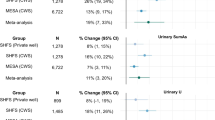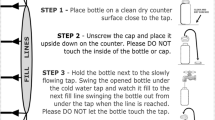Abstract
Background
Water arsenic (As) sources beyond a rural household’s primary well may be a significant source for certain individuals, including schoolchildren and men working elsewhere.
Objective
To improve exposure assessment by estimating the fraction of drinking water that comes from wells other than the household’s primary well in a densely populated area.
Methods
We use well water and urinary As data collected in 2000–2001 within a 25 km2 area of Araihazar upazila, Bangladesh, for 11,197 participants in the Health Effects of Arsenic Longitudinal Study (HEALS). We estimate the fraction of water that participants drink from different wells by imposing a long-term mass-balance constraint for both As and water.
Results
The mass-balance model suggest that, on average, HEALS participants obtain 60–75% of their drinking water from their primary household wells and 25–40% from other wells, in addition to water from food and cellular respiration. Because of this newly quantified contribution from other wells, As in drinking water rather than rice was identified as the largest source of As exposure at baseline for HEALS participants with a primary household well containing ≤50 µg/L As.
Significance
Dose-response relationships for As based on water As should take into account other wells. The mass-balance approach could be applied to study other toxicants.
This is a preview of subscription content, access via your institution
Access options
Subscribe to this journal
Receive 6 print issues and online access
$259.00 per year
only $43.17 per issue
Buy this article
- Purchase on Springer Link
- Instant access to full article PDF
Prices may be subject to local taxes which are calculated during checkout





Similar content being viewed by others
References
BGS, DPHE. Arsenic contamination of groundwater in Bangladesh. Vol 1: summary. In: Kinniburgh DG, Smedley PL, editors. British Geological Survey Technical Report WC/00/19. Keyworth: British Geological Survey; 2001.
Brammer H, Ravenscroft P. Arsenic in groundwater: a threat to sustainable agriculture in South and South-east Asia. Environ Int. 2009;35:647–54.
Argos M, Kalra T, Rathouz PJ, Chen Y, Pierce B, Parvez F, et al. Arsenic exposure from drinking water, and all-cause and chronic-disease mortalities in Bangladesh (HEALS): a prospective cohort study. Lancet. 2010;376:252–8. https://doi.org/10.1016/S0140-6736(10)60481-3.
Chen Y, Graziano JH, Parvez F, Liu M, Slavkovich V, Kalra T, et al. Arsenic exposure from drinking water and mortality from cardiovascular disease in Bangladesh: prospective cohort study. BMJ. 2011;342:d2431 https://doi.org/10.1136/bmj.d2431.
Flanagan SV, Johnston RB, Zheng Y. Arsenic in tube well water in Bangladesh: health and economic impacts and implications for arsenic mitigation. Bull World Health Organ. 2012;90:839–46. https://doi.org/10.2471/BLT.11.101253.
Smith AH, Lingas EO, Rahman M. Contamination of drinking-water by arsenic in Bangladesh: a public health emergency. Bull World Health Organ. 2000;78:1093–103.
Sohel N, Persson LA, Rahman M, Streatfield PK, Yunus M, Ekström E-C, et al. Arsenic in drinking water and adult mortality: a population-based cohort study in rural Bangladesh. Epidemiology. 2009;20:824–30. https://doi.org/10.1097/EDE.0b013e3181bb56ec.
Wasserman GA, Liu X, Parvez F, Ahsan H, Factor-Litvak P, van Geen A, et al. Water arsenic exposure and children’s intellectual function in Araihazar, Bangladesh. Environ Health Perspect. 2004;112:1329–33. https://doi.org/10.1289/ehp.6964.
Rahman A, Vahter M, Ekstrom E-C, Rahman M, Golam Mustafa AHM, Wahed MA, et al. Association of arsenic exposure during pregnancy with fetal loss and infant death: a cohort study in Bangladesh. Am J Epidemiol. 2007;165:1389–96. https://doi.org/10.1093/aje/kwm025
Rahman A, Persson L-Å, Nermell B, El Arifeen S, Ekström E-C, Smith AH, et al. Arsenic exposure and risk of spontaneous abortion, stillbirth, and infant mortality. Epidemiology. 2010;21:797–804. https://doi.org/10.1097/EDE.0b013e3181f56a0d.
Quansah R, Armah FA, Essumang DK, Luginaah I, Clarke E, Marfoh K, et al. Association of arsenic with adverse pregnancy outcomes/infant mortality: a systematic review and meta-analysis. Environ Health Perspect. 2015;123:412–21. https://doi.org/10.1289/ehp.1307894.
Shih YH, Islam T, Hore SK, Sarwar G, Shahriar MH, Yunus M, et al. Associations between prenatal arsenic exposure with adverse pregnancy outcome and child mortality. Environ Res. 2017;158:456–61.
Ahsan H, Chen Y, Parvez F, Zablotska L, Argos M, Hussain I, et al. Arsenic exposure from drinking water and risk of premalignant skin lesions in Bangladesh: baseline results from the Health Effects of Arsenic Longitudinal Study. Am J Epidemiol. 2006;163:1138–48. https://doi.org/10.1093/aje/kwj154.
Pan WC, Seow WJ, Kile ML, Hoffman EB, Quamruzzaman Q, Rahman M, et al. Association of low to moderate levels of arsenic exposure with risk of type 2 diabetes in Bangladesh. Am J Epidemiol 2013;178:1563–70. https://doi.org/10.1093/aje/kwt195.
Biggs ML, Kalman DA, Moore LE, Hopenhayn-Rich C, Smith MT, Smith AH. Relationship of urinary arsenic to intake estimates and a biomarker of effect, bladder cell micronuclei. Mutat Res. 1997;386:185–95. https://doi.org/10.1016/s1383-5742(97)00012-4.
Mandal BK, Chowdhury TR, Samanta G, Mukherjee DP, Chanda CR, Saha KC, et al. Impact of safe water for drinking and cooking on five arsenic-affected families for 2 years in West Bengal, India. Sci Total Environ. 1998;218:185–201. https://doi.org/10.1016/s0048-9697(98)00220-4.
Calderon RL, Hudgens E, Le XC, Schreinemachers D, Thomas DJ. Excretion of arsenic in urine as a function of exposure to arsenic in drinking water. Environ Health Perspect. 1999;107:663–7. https://doi.org/10.1289/ehp.99107663.
Vahter ME, Li L, Nermell B, Rahman A, El Arifeen S, Rahman M, et al. Arsenic exposure in pregnancy: a population-based study in Matlab, Bangladesh. J Health Popul Nutr. 2006;24:236–45.
Kile ML, Hoffman E, Hsueh YM, Afroz S, Quamruzzaman Q, Rahman M, et al. Variability in biomarkers of arsenic exposure and metabolism in adults over time. Environ Health Perspect. 2009;117:455–60. https://doi.org/10.1289/ehp.11251.
Smith AH, Yunus M, Khan AF, Ercumen A, Yuan Y, Smith MH, et al. Chronic respiratory symptoms in children following in utero and early life exposure to arsenic in drinking water in Bangladesh. Int J Epidemiol. 2013;42:1077–86. https://doi.org/10.1093/ije/dyt120
Sohel N, Kanaroglou PS, Persson LA, Haq MZ, Rahman M, Vahter M. Spatial modelling of individual arsenic exposure via well water: evaluation of arsenic in urine, main water source and influence of neighbourhood water sources in rural Bangladesh. J Env Monit. 2010;12:1341–8. https://doi.org/10.1039/c001708f.
Pomroy C, Charbonneau SM, McCullough RS, Tam GKH. Human retention studies with 74As. Toxicol Appl Pharm. 1980;53:550–6.
El Masri HA, Hong T, Henning C, Mendez W, Hudgens EE, Thomas DJ, et al. Evaluation of a physiologically based pharmacokinetic (PBPK) model for inorganic arsenic exposure using data from two diverse human populations. Environ Health Perspect. 2018;126:077004. https://doi.org/10.1289/EHP3096.
El-Masri HA, Kenyon EM. Development of a human physiologically based pharmacokinetic (PBPK) model for inorganic arsenic and its mono- and di-methylated metabolites. J Pharmacokinet Pharmacodyn. 2008;35:31–68.
Hudgens EE, Drobna Z, He B, Le XC, Styblo M, Rogers J, et al. Biological and behavioral factors modify urinary arsenic metabolic profiles in a U.S. population. Environ Health. 2016;15:62 https://doi.org/10.1186/s12940-016-0144-x.
Ahsan H, Chen Y, Parvez F, Argos M, Hussain AI, Momotaj H, et al. Health Effects of Arsenic Longitudinal Study (HEALS): description of a multidisciplinary epidemiologic investigation. J Expo Sci Environ Epidemiol. 2006;16:191–205. https://doi.org/10.1038/sj.jea.7500449.
Hogan K, Marcus A, Smith R, White P. Integrated exposure uptake biokinetic model for lead in children: empirical comparisons with epidemiologic data. Environ Health Perspect. 1998;106:1557–67. https://doi.org/10.1289/ehp.98106s61557.
Parvez F, Chen Y, Argos M, Iftikhar Hussain AZM, Momotaj H, Dhar R, et al. Prevalence of arsenic exposure from drinking water and awareness of its health risks in a Bangladeshi population: results from a large population-based study. Environ Health Perspect. 2006;114:355–9. https://doi.org/10.1289/ehp.7903.
Kubachka KM, Shockey NV, Hanley TA, Conkli SD, Heltkempe TD. Arsenic speciation in rice products using high performance liquid chromatography-inductively coupled plasma-mass spectrometric determination. Section 4.11 Elemental analysis manual for food and related products. US Food and Drug Administration. 2012. https://www.fda.gov/media/95197/download Accessed 6, Oct 2021.
Yousuf AK, Misbahuddin M, Rahman MS. Secretion of arsenic, cholesterol, vitamin E, and zinc from the site of arsenical melanosis and leucomelanosis in skin. Clin Toxicol (Philos). 2011;49:374–8. https://doi.org/10.3109/15563650.2011.577747.
Genuis SJ, Birkholz D, Rodushkin I, Beesoon S. Blood, urine, and sweat (BUS) study: monitoring and elimination of bioaccumulated toxic elements. Arch Environ Contam Toxicol. 2011;61:344–57. https://doi.org/10.1007/s00244-010-9611-5.
Yip L, Dart R. Arsenic. In: Sullivan J, Kreiger G, editors. Clinical environmental health and toxic exposures. Philadelphia, PA: Lippincott Williams & Wilkins; 2001. p. 858–65.
Popkin BM, Kristen DE, Rosenberg IH. Water, hydration and health. Nutr Rev. 2011;68:439–58. https://doi.org/10.1111/j.1753-4887.2010.00304.x.Water.
Gomella LG, Haist SA. Chapter 9. Fluids and electrolytes. In: Clinician’s pocket reference: The Scut Monkey. 11th ed. Gomella and Haist editors. New York: McGraw-Hill; 2007.
van Geen Y, Zheng R, Versteeg M, Stute A, Horneman R, Dhar, et al. Spatial variability of arsenic in 6000 tube wells in a 25 km2 area of Bangladesh. Water Resour Res. 2003;39:1140 https://doi.org/10.1029/2002WR001617.
Adolph EF & Associates. Physiology of man in the desert. New York: Interscience Publishers Inc.; 1947.
Mack GW, Nadel ER. Body fluid balance during heat stress in humans. In: Comprehensive physiology. editors. Fregly MJ, Blatteis. CM Hoboken, NJ, USA: John Wiley & Sons, Inc.; 2011. p. 187–214.
Cain M, Khanam SR, Nahar S. Class, patriarchy, and women’s work in Bangladesh. Popul Dev Rev. 1979;5:405–38.
Huhmann BL, Harvey CF, Navas-Acien A, Graziano J, Parvez F, Chen Y, et al. Changes in arsenic exposure in Araihazar, Bangladesh from 2001 through 2015 following a blanket well testing and education campaign. Environ Int. 2019;125:82–89.
Javed A, Farooqi A, Baig ZU, Ellis T, van Geen A. Soil arsenic but not rice arsenic increasing with arsenic in irrigation water in the Punjab plains of Pakistan. Plant Soil. 2020;450:601–11. https://doi.org/10.1007/s11104-020-04518-z.
Acknowledgements
We thank the entire HEALS team in Araihazar and students of the Geology Department at Dhaka University for collecting the well water and urine samples.
Funding
This research was supported by the Abdul Latif Jameel Water and Food Systems Lab (J-WAFS) and by NIEHS grants P42 ES10349 and S10 OD 16384. LBH was supported by an NSF Graduate Research Fellowship.
Author information
Authors and Affiliations
Contributions
LBH, CFH and AvG conceived the study based on urine and well water data previously collected under a cohort study conducted by HA, JG, and AvG. VS was responsible for new rice arsenic measurements. YC, MA, and AN-A contributed to the interpretation of the results. LBH drafted the paper, which was then edited by AvG based on input from all authors.
Corresponding author
Ethics declarations
Competing interests
The authors declare no competing interests.
Additional information
Publisher’s note Springer Nature remains neutral with regard to jurisdictional claims in published maps and institutional affiliations.
Supplementary Information
Rights and permissions
About this article
Cite this article
Huhmann, L.B., Harvey, C.F., Navas-Acien, A. et al. A mass-balance model to assess arsenic exposure from multiple wells in Bangladesh. J Expo Sci Environ Epidemiol 32, 442–450 (2022). https://doi.org/10.1038/s41370-021-00387-5
Received:
Revised:
Accepted:
Published:
Issue Date:
DOI: https://doi.org/10.1038/s41370-021-00387-5



